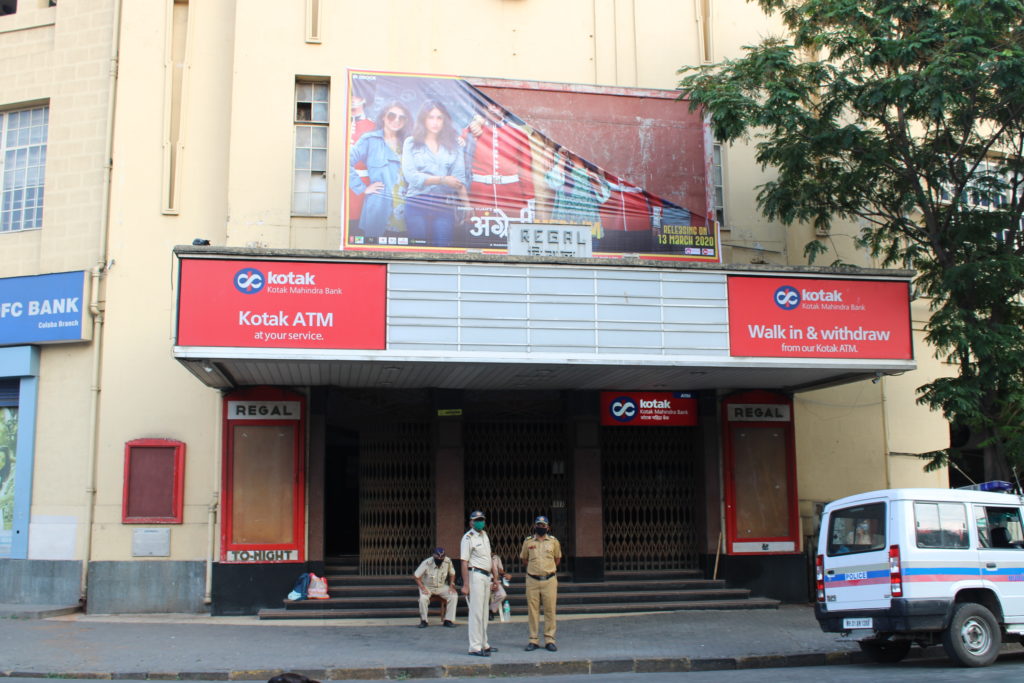No camera, no lights, no action!
Employing nearly 2.5 million people, with an overwhelming number on daily wages, the cinema industry is doing precious little to aid the most vulnerable of their lot.
India’s lockdown started with the closure of cinema halls and much before the Prime Minister’s speech of March 24, locking India’s 1.35 billion people indoors for three weeks. For the cinema industry, the signs of trouble had emerged as early as March 15 when various state governments ordered cinemas to shut as a preventive measure. The Coronavirus was not one to allow casual camaraderie and the Indian film industry was not anxious to play catalyst, contributing to its spread.
Working in tandem with state governments across the country, the industry associations issued advisories across the nation to follow suit. Motion Picture Association in the north. Bengal Film and Television Chamber of Commerce in the east. South India Film Chamber of Commerce in the south (combining Tamil, Telugu, Kannada and Malayalam language films). In Mumbai, all major associations including IMPPA, WIFPA, FWICE, IFTDA, IFTPC and ASAP got together and called for halting all shooting, pre and post production related activities, entertainment related shows, events and gatherings till March-end when the matter would be reviewed for further action. And the Prime Minister put paid to all that with the announcement of a 21-day nationwide lockdown starting midnight of March 24.
“There are several important dates and festivals that make this period a very crucial one for big releases. March 25 was Gudi Padwa and Cheti Chand. Another new year is around the corner, Labour Day is on May 1. It is the time for releases before schools re-open. All the big business that was expected has evaporated in thin air.Several films in all languages were going great guns when stoppage was announced, sure they will be shown once the cinema houses open again but what will be the footfalls? Many films scheduled for release right now including blockbuster releases have been indefinitely postponed. The focus for us now is the concern for our weaker sections. They need priority attention. This is not the time to take them for granted,” says Ravi Kottarakara, general secretary, Film Federation of India (FFI) and South India Film Chamber of Commerce (SIFCC).
Most Indians were now worried as to where they would get their daily rations from, for 2.5 million daily wage workers in the film industry across the nation the question was more ominous, how? Both in terms of money and logistics!
Up until now, the dazzle of the bright arc lights has blinded all but a few from taking a closer look at those who dwell in the lurking shadows beneath. As many as 80 pc of the workers on any film set are daily wage workers, supporting many dependents, living hand-to-mouth with little or no savings. While the technicians and their assistants, who receive comparatively handsome remunerations from their producers, there are the others, hundreds of thousands of them – spot boys, light boys, set workers among others – the unskilled and semi-skilled labour for whom cessation of shooting, screening and all such activity would mean extinguishing of kitchen fires.
Sure enough, efforts got underway, simultaneously in various parts of the country, but not necessarily in synch, to raise funds, distribute ration packets and identify the needy,more knee jerk reactions than a concerted effort. Mind you, there is no question of discounting the honourable intent of the moment here, nor casting any aspersions on the well-intentioned; just an attempt to spotlight the lack of cohesion and preparedness for the emergency situation.
The dark clouds of Corona have revealed the underbelly of an ostensibly rich and glamorous business that seeks to disguise itself as an industry and yet, for most of the time, almost all of the time functions under the basic tenet, each one for himself or herself; where temporary individual equations are the order of the day and unscalable egos divide sections in the name of associations that have never come together as one, in the name of one,the Indian film industry. It is always north, south, west, east, never Indian! And the government of the day has not helped matters at all, instead of uniting and recognising all under the common umbrella of an industry, nurturing and harnessing the economic potential of an industry that is quite naturally the cynosure of all; political parties seek out high profile individuals as vote catchers; dividing the stars and the people for petty gains.
The irony here is remarkable. Not only do films come under “non-essential” services, not only is the business of films is considered a “luxury” business; but, to add fat to the fryer, the film industry is clubbed together with gambling, alcohol and tobacco as a “sin” industry.The hypocrisy of the powers that be is quite evident. Once again, the industry has been left to fend for itself.
With one seemingly normal, but infected person having the capacity to unwittingly infect many, imagine the propensity of 2.5 million intermingling on a daily basis. What a way to save the nation. Calculating monetary losses here are mere hypothesis. INR 109.5 billion (USD 1.4 billion) was the figure for the gross box office in 2019 according to one media consulting firm. Hoping for a repeat that would peg the daily losses to INR 300 million.
How do you measure losses of interrupted movies runs, interrupted productions, those about to start, those about to finish, and those in the middle of it all with confirmed dates of stars and studios? Those with loans taken at high interest rates, advances paid and bookings cancelled. Television channels with primetime slots booked by advertisers and no programmes to show them with. Housebound audiences with nothing new to see on their TV screens. Even when the lockdown is lifted and shutters go up, there will be no rush for cinema halls. Resources exhausted, loans taken the businesses will start, they have to but what about the economy, what happens when Corona virus ceases to be an excuse?
For Firdausul Hasan, president of Film Federation of India, the umbrella organisation of the industry, the worry is indeed about the post-Covid 19 scenario. “Re-starting is one thing but reviving the already beleaguered industry will be quite another thing. As president of Film Federation of India, my first responsibility will be to get us all together and start a meaningful dialogue with the Government for sustainable, long term, synergistic solutions that will help organise the film industry on a national level even as some wrinkles are ironed out at local and state level. We must speak as a single voice, from a single platform, not as representatives of one region or the other,” he says.
Not just the producers, even the exhibitors feel that the return to normalcy is a long way off even after the government ends the lockdown. “As an exhibitor, I can say that nothing really is in our hands. We were asked to down our shutters, we did. We wholeheartedly support the decision of the government in national interest as extraordinary situations require extraordinary actions. When things normalise we will reopen on the directions of the government. That does not mean audiences will come swarming the very next day, in fact, it will take a while for the public to come back. During the lockdown, there are many fixed expenses for the exhibitors such as salaries, minimum electricity charges, rentals, etc. Once the cinema houses open, with very low footfalls, without new releases of films, with resources having depleted over this period, one wonders how many single screens will have the wherewithal to get up and running without the support and financial relief from the government; because even before the lockdown most single screens were barely able to survive,” says Sakshi Mehra, president of Motion Picture Association, comprising exhibitors and distributors of Delhi, U.P. and Uttarakhand.
T P Aggarwal, president of IMPPA, bemoans the lot of the film producers. “If it were not for the hopeful new entrants as Producers eager for name and fame, the Indian Film Industry would have closed shop a long time ago, like any other loss-making corporation. It is these new producers who come after selling their homes and assets to give an illusion of continuity and growth in the industry; in reality, many or most of these optimists disappear faster than they had come, dejected, broke and unknown. The government quite conveniently ignores this lot,” he says.
Not just the cinema, even the advertising industry has been hit as shooting of fresh creatives as well as launch of campaigns suspended. “ASAP has advised its members to stop all work pertaining to TVC production. Advertising film making works to time-bound campaigns which may have no relevance if delayed or even in a crisis like situation we are witnessing currently. Films suspended may most likely be scrapped. ASAP members are all established production houses willing to wait and watch, business will start when it has to,” says Upendra Nath Pandey, head of affairs of the association of advertising producers (ASAP).
Same is the fate of network television programming with the country counting the world’s biggest television industry in terms of number of channels. All fresh shoots of soap operas, comedy shows, reality shows and any other kind of programmes has been halted, at least upto April 15.
“All TV production has been stopped. With daily programmes, we run cut-to-cut with new episodes being ready just-in-time for telecast so there is no real bank of programmes to fall back on. It is for the channels to decide what to do. Right now, people are glued to the news channels as every now and then there are new breaking news; but our immediate concern is for our daily wage crew and mustering resources to take care of the immediate needs of the most vulnerable,’’ says J D Majethia, chairman of TV Wing of Indian Film & Television Production Companies.
The workers are trying to fend for themselves with the help of their unions. All India Film Employees Confederation (AIFEC), the mother body of all six regional federations, is raising funds to help the weakest sections in the industry. “We are already working together across the country on a war footing to raise funds, create and distribute ration packets,” says Ashok Dubey, president, AIFEC.











